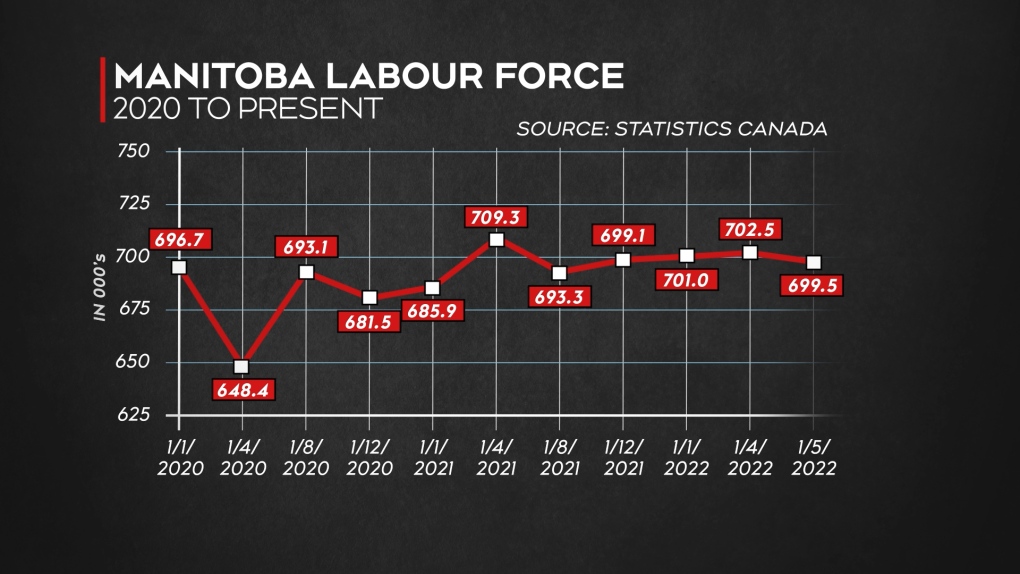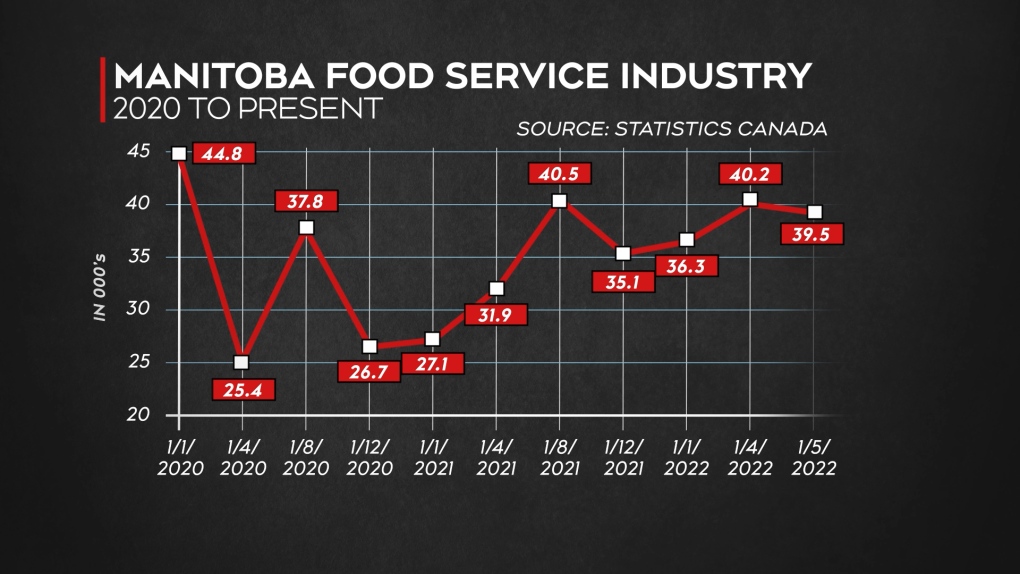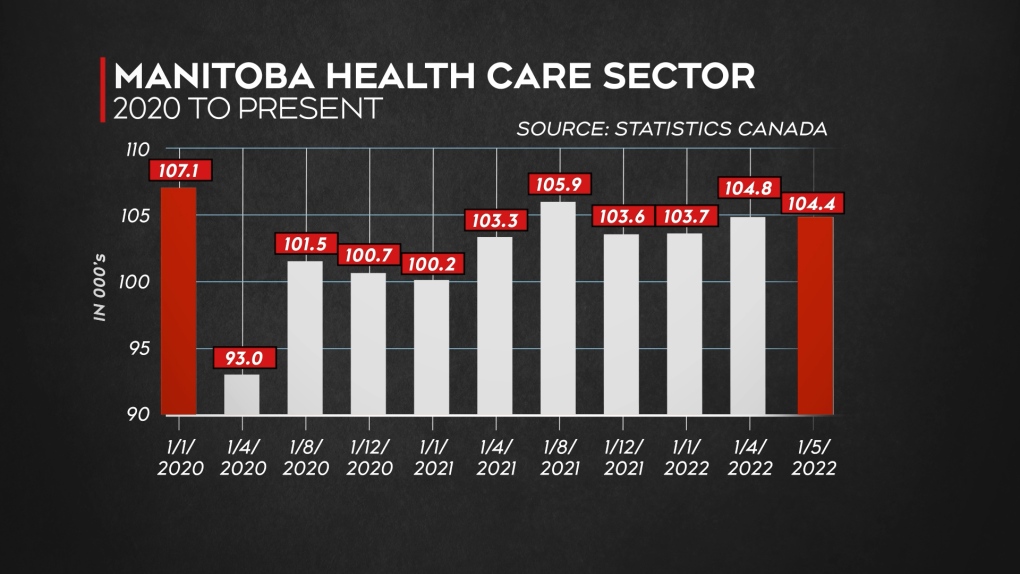Manitoba’s post-pandemic recovery: which sectors are still feeling the effects of COVID
Manitoba’s workforce shrank slightly in May, the labour force losing 500 jobs, bucking a recent trend of economic gains following the removal of pandemic-related restrictions, according to new federal data.
All of the job losses were in part-time work, with the province adding 200 full-time employment positions.
The province’s unemployment rate is now 4.7 per cent, one of the lowest among provinces, and even lower than in Feb. 2020, before the pandemic hit.

"Right now the job market in Manitoba is pretty strong,” said Fletcher Baragar, associate professor of economics at the University of Manitoba, “The labour market as a whole, in terms of providing jobs and employment, is in pretty good shape.”
That is true for most of Manitoba’s economic sectors, with the majority approaching, reaching, or exceeding pre-pandemic employment levels.
Some sectors, however, are still lagging in their post-restriction recovery.
“Some have bounced back, some are still bouncing back and are not quite back at pre-pandemic levels,” said Baragar. “In particular the food services and accommodations sector.”
Manitoba’s food service industry experienced the sharpest employment losses and gains amid the pandemic, mostly tied to when COVID-19 restrictions were imposed or loosened.

Before the pandemic hit, the food service sector employed around 44,000 persons, dropping to as low as 25,400 in March 2020 when a state of emergency was declared by the province, and employment levels at the end of the year – despite gains in the months between – were only slightly higher.
According to the most recent data, the sector is close to early 2020 employment levels, though pandemic-related employment disruptions may have long-term staffing consequences.
"Two years of being told that you're open and closed, unfortunately, that creates messaging that subliminally creates a little bit of apprehension to go into the hospitality industry," said Shaun Jeffrey, executive director & CEO of the Manitoba Restaurant & Food Services Association.
The restaurant industry is facing a staffing crunch right now, says Jeffrey, one that’s persisted since Manitoba started lifting COVID-19 restrictions.
Most restaurants are looking for both experienced workers and those new to the industry, he says, though the loss of many long-term industry workers amid the pandemic is adding to labour-related difficulties.
“When you lose a good chunk of your long-term staff, those are your trainers… key players that will train the new staff and you can count on to run the operation,” Jeffrey said.
Manitoba’s health-care sector experienced similar, if less dramatic, employment fluctuations throughout the pandemic.
Despite the high demand for health-care workers posed by the pandemic, the health-care and social assistance sector shrank by six per cent by the end of 2020. Gains and losses continued into 2021 and, right now, the sector is still below Feb. 2020 levels.

“Health-care has really suffered over the last two and a half years,” said Darlene Jackson, president of the Manitoba Nurses Union, “With the loss of nurses, loss of professionals, loss of experience, and loss of talent.”
Experienced nurses left the sector due to long hours and ever-changing schedules forced on them by the pandemic, says Jackson, with many younger, newer nurses doing the same.
“It really is frightening to see how many nurses are leaving the system,” she said, “We know, right now, we have just about 2,500 vacant nursing positions.”
On Wednesday, the province announced funding to add 30 more nurse training seats at Red River College Polytechnic, a measure meant to address the ongoing nursing shortage.
However, it’s not just nurses leaving the health-care sector.
“What we’re hearing from people is that they are leaving their professions much earlier than they would normally,” said Bob Moroz, president of the Manitoba Association of Health Care Professionals.
“That comes down to stress and burnout,” he said.
Manitoba’s agricultural sector is also lagging when compared to pre-pandemic levels.
The sector experienced modest employment losses over the course of 2020 and most of 2021, not losing more than one or two thousand workers for a sustained period of time.
Towards the end of 2021, however, the agricultural sector experienced heavier losses, a trend that’s continued in recent months.
In May, the sector did grow to a workforce of 19,000, an increase of about 200 jobs from April.
Recent weather events, like the spring snowstorm and heavy rainfall causing overland flooding, are the major contributing factor, according to Keystone Agricultural Producers.
“When we’re unable to get on the land and do our spring seeding, that would impact the amount of labour force required,” said Bill Campbell, KAG’s president.
“We are probably three weeks behind and that would indicate the month of April and part of May,” he said.
Campbell anticipates employment levels return to normal – which is around the 24,000 workers mark – in the months ahead, noting, however, that growers are experiencing difficulties accessing certain products due to supply chain issues.
"We are probably three weeks behind and that would indicate the month of April and part of May wouldn’t require the same labour force," he said.
"We should be able to see a return to normal statistics, even though we’re still encountering supply chain issues in terms of availability of supplies… Hope to return to normal levels of employment."
It could just be a matter of time before all of Manitoba’s economic sectors rebound from COVID-related losses.
A shortage of workers to fill positions may slow down that process, says Chuck Davidson, CEO of the Manitoba Chambers of commerce.
“When I'm talking to employers now and they're telling me we can't find workers,” he said, noting how the pandemic drastically shifted the province’s economic outlook, putting businesses in a bind.
From 2010 to 2018, Manitoba’s economy increased by about one per cent (or 10,000 jobs) every year, barring a couple years of stagnation.
At the end of 2018, the province’s labour market was almost 700,000 workers strong.
If COVID didn’t hit the province – and the province’s economic trajectory stayed steady at 1 per cent growth annually – Manitoba’s workforce would be between 720,000 – 730,000 “There are 20,000 people employers would be willing to hire that aren't there right now,” said Davidson.
Two other economic factors, namely rising inflation and high fuel costs, are compounding the labour shortage problem.
“It’s become almost a perfect storm of challenges for businesses,” he said, "We're dealing with all of these different cost pressures that are making it even more challenging to get back to where you were pre-pandemic.”
“What this is going to do is it's going to slow things down."
Davidson says increasing immigration rates into Manitoba will help with the labour shortage.
Unfortunately, inflation is a problem that probably isn’t going away any time soon, says Phil Cyrenne, professor of economics at the University of Winnipeg.
“There is evidence that inflation will persist, I think, for at least another six months if not longer than that,” Cyrenne said, adding that the rising cost of goods – and corresponding interest rate hikes from the Bank of Canada – could limit growth across Manitoba’s economy.
Higher costs at the gas pump will also add to costs for businesses “because fuel prices feed into so much of the economy,” said Cyrenne, “From transporting supplies to stores to fuel for farm machinery.”
It’s not all bad news.
A tight labour market and higher cost of living could benefit workers, especially after the many employment-related disruptions and losses spurred on by the pandemic.
“We could see a renewed appreciation of the value of retaining skilled workers and being attractive to new entrants in the labour force,” said Barager.
“We may see, as a result of that, improvements in terms of wages for workers and added benefits to draw new workers into that particular place of employment.”
CTVNews.ca Top Stories

Possible scenarios that could play out in Ottawa as the Liberal government teeters
Prime Minister Justin Trudeau is said to be reflecting on his future over the holidays after the resignation of his top cabinet minister, Chrystia Freeland, in mid-December. The bombshell move prompted a fresh wave of calls for Trudeau to step down as Liberal leader from inside and outside the caucus.
LIVE UPDATES Latest info: FBI says the New Orleans truck attacker acted alone in an 'act of terrorism'
The FBI now says the New Orleans truck attacker acted alone in an 'act of terrorism' when he drove a pickup truck into a crowd of New Year's revellers early Wednesday, killing 14 people.
Woman, father killed on New Year's Eve were victims of intimate partner violence: Halifax police
Halifax police are investigating three deaths that are connected – two of which they say were homicides resulting from intimate partner violence – in the city on New Year’s Eve.
Man who died in Tesla Cybertruck explosion was active-duty U.S. Army soldier, officials say
The person who authorities believe died in the explosion of a Tesla Cybertruck packed with firework mortars and camp fuel canisters outside U.S. president-elect Donald Trump's Las Vegas hotel was an active-duty U.S. Army soldier, three U.S. officials told The Associated Press on Thursday.
FORECAST Weather warnings issued in 6 provinces and territories
Wintry weather conditions, including heavy snow and wind chill values around -55, prompted warnings in six provinces and territories early Thursday morning.
Sask. RCMP locate missing inmate of Yorkton prison
An inmate who was wanted for being unlawfully-at-large after not returning to Whitespruce Provincial Training Centre in Yorkton has been found and arrested.
5 things we know and still don't know about COVID, 5 years after it appeared
The virus is still with us, though humanity has built up immunity through vaccinations and infections. It's less deadly than it was in the pandemic's early days and it no longer tops the list of leading causes of death. But the virus is evolving, meaning scientists must track it closely.
Who are Canada's top-earning CEOs and how much do they make?
Canada's 100 highest-paid CEOs earned $13.2 million on average in 2023 from salaries, bonuses and other compensation, according to the Canadian Centre for Policy Alternatives.
More Popsicles, please: Your tonsils can grow back
Tonsil regrowth is rare. Here's one woman's experience when she had to get her tonsils removed – again.


































